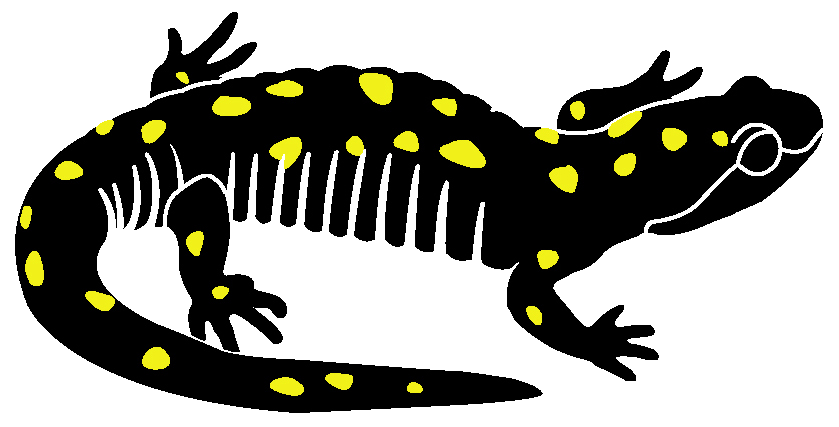Spotted Salamander
Ambystoma maculatum
Heading 1

2. Spotted salamanders males congress in a vernal pool in early spring. They produce spermatophores, the white objects scattered on the pool bottom.

1. The spotted salamander, Ambystoma maculatum, is a fossorial salamander seldom seen because of its secretive nature and nocturnal feeding habits.

3. Females spotted salamanders produce an egg mass several days after fertiliztion. She attaches the mass to underwater vegetation or woody debris in the pool.

4. Salamanders deposit their egg masses in communal clusters in a sunny area which has sufficient depth to keep the eggs submerged until hatching.

6. Spotted salamander larvae have distinctive bushy external gills. Older larvae have all four legs.

5. A symbiotic green alga, Oophila amblystomatis, grows within the eggs and the mass.
Larvae
The .5" larvae hatch about 6-8 weeks after egg deposition. Larvae have feathery external gills just behind the head and below these, a pair of “balancers” which keep them upright. Balancers are lost after a couple of days. Larvae grow quickly, feeding on daphnia, small insect larvae (chironomid midge, etc.), oligochaete worms, and other small invertebrates. At maturity, they are 2-3". They are eaten by predatory insects (predaceous diving beetles, their larvae, and giant water bugs), other ambystomatid larvae, as well as turtles.
Sweeping a fine net along the leaves on the pool bottom will often capture larvae. The external gills can be easily observed if the larvae is placed in a container of water. As pools dry, larval development accelerates. The external gills disappear as the metamorph becomes a land-dwelling animal. Look for emerging metamorphs in and under vegetation and debris at the pool edge (7).
Eggs
On breeding nights, males produce many spermatophores in the area of congressing. A female picks up sperm from several spermatophores and her eggs are internally fertilized. Within a few days the female produces a single large or several smaller egg masses which she will attach to vegetation near the water surface (3).
Many salamanders may use the same attachment site and produce communal egg mass clusters (4). Egg masses consist of 30 to 250 individual eggs surrounded by a stiff gelatinous matrix. The masses range in diameter from 1 to 6 inches. The entire mass may be clear or white. As the eggs develop over several weeks, masses become green from the alga Oophila amblystomatis (5).
Egg masses may be distinguished from other salamander species by their firm texture, similar to set gelatin. Individual eggs have a relatively large space between the vitelline membrane and the outer edge of the egg.
Egg masses are attached to vegetation in sunny locations in vernal pools and can be found anytime from early spring (mid-March) through May. Eggs are preyed upon by spotted turtles, caddisfly larvae (Phryganeidae), leeches and other predators. The gelatinous matrix will protect the embryos from temporary stranding if water levels recede for short periods. Look for egg hatching from mid-May onward.
Adults
The adult spotted salamander (1) is a large (4.5-8") amphibian appropriately named for its obvious yellow spots on a blackish body. This animal is unmistakable, though not often encountered other than when accidently discovered under logs or when migrating to vernal pools on rainy nights in spring for breeding. Adults spend their lives in forested areas within a half mile of a vernal pool. They frequent small mammal burrows, crevices in rock walls and tunnels beneath logs in soft soil, seldom venturing in the open except to feed at night. Though unfamiliar to most because of their habits, the spotted salamander is probably abundant where suitable habitat still exists. Populations will often persist in diminished numbers where habitat has been disturbed. Adults eat various invertebrates including worms, centipedes, crickets, spiders, etc.
Spotted salamanders can be found on rainy nights in early spring as they migrate to vernal pools to breed. Migration has many natural hazards but crossing roads with vehicle traffic can inflict high mortality. In some towns, roads are closed and interested individuals gather to view mass migrations. Often the animals migrate on several rainy nights. At vernal pools, the salamanders gather in a “congress” where males court females in an aquatic swarm of salamanders (2).


